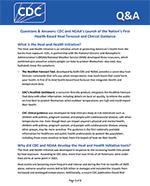An official website of the United States government

The .gov means it’s official.
Federal government websites often end in .gov or .mil. Before sharing sensitive information, make sure you’re on a federal government site.
The site is secure.
The https:// ensures that you are connecting to the official website and that any information you provide is encrypted and transmitted securely.

The President’s Task Force on Environmental Health Risks and Safety Risks to Children is the focal point for coordinating federal government efforts to explore, understand, and act together to improve children's safety and environmental health.
The Task Force works to address preventable environmental factors that lead to differences in the burden of asthma for poor and minority children relative to their peers.
The Task Force coordinates interagency efforts to better understand and prevent disease and disabilities in children from lead, including development of a new federal lead strategy.
Understanding and predicting disease and disabilities in children across their life stages that result from exposures to chemicals and metals, including pesticides, manufacturing ingredients, lead, and others, is a focus of the Task Force.
The Task Force seeks to identify key strategies to understand and address climate change impacts on children’s health and to inform federal agencies and others engaged in climate change mitigation, adaptation, and response.
Healthy settings (such as homes, schools, and daycares) have eight primary qualities: dry, clean, pest-free, safe, contaminant-free, well ventilated, well maintained, and thermally controlled. The Task Force works to ensure healthy settings for all children.

The week of July 15-19, the National Integrated Heat Health Information (NIHHIS) Interagency Communications Group is holding the second of three heat season awareness social media campaigns. The President’s Task Force is participating by sharing federal agency member materials and information that interested groups can use to communicate actions individuals and communities can take to prepare for heat and prevent heat-related illness and death, especially among vulnerable infants and children. This activity is part of coordinated federal activities to address the threat of health impacts to heat. More information is available at Heat.gov.
For more on the Heat Season Awareness campaign and related federal agency social media resources, please see the full article.

For children with asthma, heat can provoke asthma symptoms, especially because warmer temperatures can worsen air quality. Breathing polluted air can trigger asthma attacks. In addition, humidity and dehydration can worsen lung function and can contribute to more severe asthma symptoms. Poor and minority children overall experience higher rates of asthma and can suffer disparate impacts from heat. The Heat and Health Initiative has released Clinical Guidance to help health care providers keep at-risk individuals such as children with asthma safe when temperatures rise. This guidance is the first nationally available information for healthcare and public health professionals to protect the population, including those more sensitive to heat, from the impact of heat on their health. Included in the guidance are Patient Management and Patient Toolkits with tips and action plans for both children and teens with asthma.